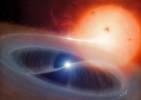
Variables cataclysmiques
Classification GCVS
These are variable stars showing outbursts caused by thermonuclear
burst processes in their surface layers (novae) or deep in their
interiors (supernovae). We use the term "novalike" for
variables that show novalike outbursts caused by rapid energy
release in the surrounding space (UG-type stars - see N Novae. Close binary systems with orbital periods from 0.05 to 230
days. One of the components of these systems is a hot dwarf star
that suddenly, during a time interval from one to several dozen or Some novae reveal pulsations of hot components with periods of approximately 100 s and amplitudes of about 0.05 mag in V after an outburst. Some novae eventually turn out to be eclipsing systems. According to the features of their light variations, novae are subdivided into fast (NA), slow (NB), very slow (NC), and recurrent (NR) categories. NA Fast novae displaying rapid light increases and then, having achieved maximum light, fading by 3 mag in 100 or fewer days (GK Per); NB Slow novae that fade after maximum light by 3 mag in >= 150 days (RR Pic). Here the presence of the well-known "dip" in the light curves of novae similar to T Aur and DQ Her is not taken into account: The rate of fading is estimated on the basis of a smooth curve, its parts before and after the "dip" being a direct continuation of one another; NC Novae with a very slow development and remaining at maximum light for
more than a decade, then fading very slowly. Before an outburst
these objects may show long-period light changes with amplitudes NL Novalike variables, which are insufficiently studied objects resembling novae by the characteristics of their light changes or by spectral features. This type includes, in addition to variables showing novalike outbursts, objects with no bursts ever observed; the spectra of novalike variables resemble those of old novae, and small light changes resemble those typical for old novae at minimum light. However, quite often a detailed investigation makes it possible to reclassify some representatives of this highly inhomogeneous group of objects into other types; NR Recurrent novae, which differ from typical novae by the fact that two or more outbursts (instead of a single one) separated by 10-80 years have been observed (T CrB). UG U Geminorum-type variables, quite often called dwarf novae. They are
close binary systems consisting of a dwarf or subgiant K-M star
that fills the volume of its inner Roche lobe and a white dwarf UGSS SS Cygni-type variables (SS Cyg, U Gem). They increase in brightness by 2-6 mag in V in 1-2 days and in several subsequent days return to their original brightnesses. The values of the cycle are in the range 10 days to several thousand; UGSU SU Ursae Majoris-type variables. These are characterized by the presence of two types of outbursts called "normal" and "supermaxima". Normal, short outbursts are similar to those of UGSS stars, while supermaxima are brighter by 2 mag, are more than five times longer (wider), and occur several times less frequently. During supermaxima the light curves show superposed periodic oscillations (superhumps), their periods being close to the orbital ones and amplitudes being about 0.2-0.3 mag in V. Orbital periods are shorter than 0.1 days; companions are of dM spectral type; UGZ Z Camelopardalis-type stars. These also show cyclic outbursts differing from UGSS variables by the fact that sometimes after an outburst they do not return to the original brightness, but during several cycles retain a magnitude between maximum and minimum. The values of cycles are from 10 to 40 days, while light amplitudes are from 2 to 5 mag in V. ZAND Symbiotic variables of the Z Andromedae type. They are close binaries consisting of a hot star, a star of late type, and an extended envelope excited by the hot star's radiation. The combined brightness displays irregular variations with amplitudes up to 4 mag in V. A very inhomogeneous group of objects. |
|
|---|---|
Abbréviations Catalogue DOWNES
UG U Gem variable (dwarf nova) UGZ U Gem variable (Z Cam subtype) UGSS U Gem variable (SS Cyg subtype) UGSU U Gem variable (SU UMa subtype) UGWZ U Gem variable (WZ Sge subtype) N nova NA fast nova NB slow nova NC very slow nova NR recurrent nova NRA recurrent nova - giant donor (Webbink et al. 1987, Ap.J., 314, 653) NRB recurrent nova - non-giant donor (Webbink et al. 1987, Ap.J., 314, 653) SN possible supernova with no galaxy visible NL novalike variable NLV novalike variable (V Sge subtype; Steiner and Diaz 1998, PASP, 110, 276) UX novalike variable (UX UMa subtype) VY novalike variable (VY Scl subtype - systems which undergo low states) AM AM Herculis variable (synchronous rotators) DQ DQ Herculis variable (non-synchronous rotators) CV cataclysmic variable (no type classification) CBSS close binary supersoft x-ray source IBWD interacting binary white dwarf Z AND symbiotic variable (Z And subtype) |
|---|
Ressources Internet
Bibliographie
Cataclysmic variables stars : How and Why the vary, Hellier,C., Springer, 2001